The most expensive Titanic artefact ever sold at auction, regarded as the 'Holy Grail of Titanic memorabilia', is the 33-foot wide (10m 05cm) Indian ink and colour washed plan currently on display at Titanic Belfast and prepared by White Star’s Naval Architects’ Department for use at the Wreck Commissioner’s Court of Inquiry into the loss of Titanic.
The man responsible for producing this enormous plan was White Star’s forty-five year old Naval Architect Cecil Arthur Allen1.
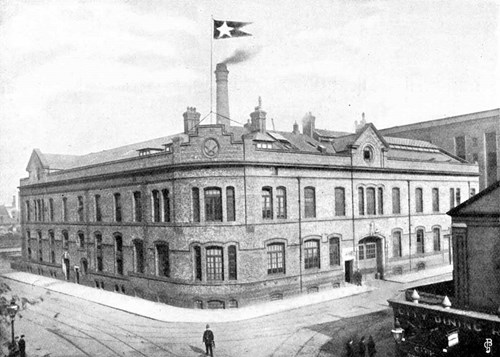
As head of the Company’s drawing offices at Oceanic Chambers, part of the giant White Star Works in Strand Road, Bootle near Liverpool, together with his small staff had just a matter of days to produce these plans. One of the highest paid members of the Works department, Allen earned £270 per year.
The longitudinal starboard plan, drawn to a scale of 3/8 inch to 1 foot, included a transverse section of Titanic, were both displayed in the Scottish Hall, Buckingham Gate, London in order to assist witnesses and members of the Court during the inquiry. The inquiry lasted thirty-six days and cost a staggering £20,549 5s (almost £1m in today’s money).

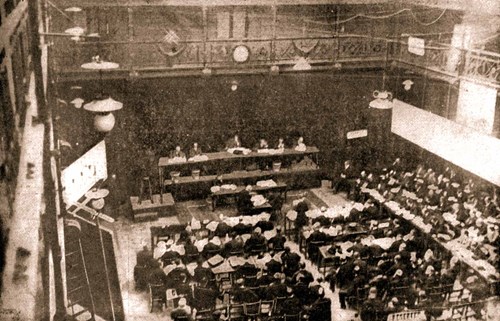
Harland & Wolff were paid £574 for the attendance of three witnesses, the supply of a large half-hull model and various plans; but no payments were made directly to White Star for the longitudinal plan; probably because drafting work was shared between the two companies and the cost of producing the plans was covered under the shipbuilder’s own expenses.
After the inquiry the plans were returned to the White Star Line. Eventually the tightly rolled bundle of drawings with a label ‘TITANIC PLANS & CHARTS’ and the hand scribbled note ‘Used at the Inquiry - Not to be destroyed’ were passed to Cunard when the two shipping companies amalgamated in 1934.
In the 1970s, part of the Cunard White Star archive stored in the basement of their offices was cleared, and the plans together with many other historically important documents were dumped in skips in the street. By chance, Norman Kerr, a bookseller specialising in transportation related subjects, was driving past in a taxi at the time and spotted what was going on. For the next few hours and in the pouring rain, Kerr filled his taxi again and again with whatever could be salvaged arranging with the driver to deliver the material to his hotel. Not until that evening and by now exhausted and soaked to the skin, having waded through mountains of rubbish to find interesting material, did he realise just what he had saved.
It seems odd looking back that such important plans should have been discarded but in the 1970s there was little academic interest in Titanic. The Titanic Historical Society, founded in 1963 in the US, did much to encourage interest in the subject and in the rest of the White Star fleet. Many of its members from around the world researched any details connected with the ship and her people and a greater understanding of Titanic’s importance and the need to preserve this aspect of maritime history came to be recognised internationally.
Advertisers also began to take an interest in Titanic as a cultural phenomenon and how the public’s growing interest could be used to their clients' advantage. An example, however, of how things can go wrong was in the Smirnoff campaign: ‘Well, they said anything could happen' in 1977. One in the series of ads featured a lady wearing nothing but expensive jewellery, cocktail glass in hand, held afloat with a life ring marked ‘S.S. TITANIC.’ The campaign included matching posters displayed on the London Underground.
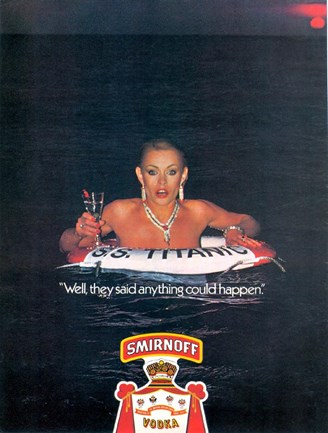
Well, something did happen. A large number of complaints about ‘bad taste’ and ‘cashing in on a terrible tragedy’ resulted in the Company reprinting the posters with an unnamed life ring. The magazine adverts remain a reminder of how advertising agencies sometimes misjudge public sensibilities even sixty-five years after an event.
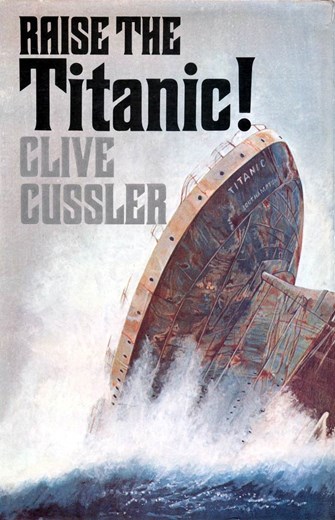
In 1979 the made for television movie ‘S.O.S. Titanic’ brought Titanic to a wider audience and a year later Clive Cussler’s best selling novel ‘Raise the Titanic!’ was turned into a major feature film. The film was a commercial flop at the cinema, the maker commenting ‘Raise the Titanic? - It would have been cheaper to lower the Atlantic!’ It was certainly true, but the film eventually became one of the most popular inflight movies of all time.
The Titanic world changed forever with the discovery of the wreck in September 1985. An explosion of interest in all things Titanic grew virtually overnight. Kerr, by now close on retirement, decided to dispose of his personal collection including the Titanic plans. In April 1987 they were sold at a specialist auction in London for £18,000. Everyone at the sale, including myself, were amazed the plans sold for such a high price but this set a pattern for anything directly connected with Titanic. The plans were subsequently resold in 2012 for £220,000 and through the generosity of the present owner the magnificent longitudinal plan, hidden from public view for the last twenty-five years, is now displayed, following conservation, in its own purpose built case in Titanic Belfast.
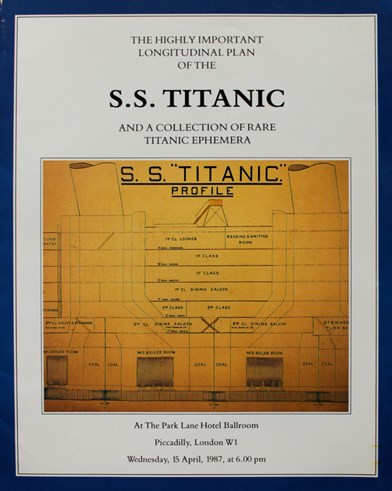
But this plan is so much more than an expensive piece of Titanic memorabilia; it is as much a blue print for disaster as the future foretold. As shipbuilders strove in the early 1900s to build ever larger and faster passenger vessels White Star and Harland & Wolff took a tremendous financial gamble with the design of the ‘Olympic’ class. The size of the vessel, the propulsion system, the facilities for passengers all had to be carefully considered against an unstable economic climate. Size was the major consideration. There was no yard large enough to construct, dock or even repair the planned vessels. Every aspect of the design and operation of the new class had to be considered afresh with no guarantee that the vessels could even be filled with passengers.
The tendency is to think of Olympic and Titanic as the best and most technically advanced liners of their day. In truth the only boast the builders and owners could make was that they were the largest liners in world. In reality Olympic and her younger sister, Titanic, were standard Harland & Wolff designs made larger. The choice of propulsion system, triple-expansion engines with a low pressure turbine was a compromise decision in order to make the vessels more economical to operate compared with their main rivals the Cunard express liners Lusitania and Mauretania driven by turbines alone. Those vessels were built with the help of a low interest loan from the British Government and an annual operating subsidy to off-set their enormous running costs. In return both vessels would, if required, be used as armed merchant cruisers in time of war; because of this special requirement many of the features in the Cunarders were far advanced, compared with the ‘Olympic’ class, and designed with so-called ‘torpedo bulkheads’ dividing their compartments into smaller spaces.
Harland & Wolff could easily have constructed the ‘Olympic’ class along similar lines to the Cunarders. In the 1880s they built two vessels to Admiralty specifications, the White Star liners Teutonic (Yard No. 208) and Majestic (Yard No. 209), also intended for use as armed merchant cruisers and operated under the same financial terms as the Cunarders. Later, and at great expense, both were converted to conventional bulkhead arrangements for two reasons; firstly, operation of the vessels was considerably more difficult then a conventionally designed merchant vessel and, secondly, the reduced cargo space increased operating costs. With such a costly project as the ‘Olympic’ class it was impossible to ignore the financial realities of operating vessels of this size. Unless the Company achieved a passengers and freight capacity approaching 75% it would lose money; therefore the decision was made to design and construct the class along conventional lines.
Merchant shipbuilding was steeped in tradition and the stern of Titanic as detailed in the longitudinal plan reveals more about past thinking than future development. The graceful overhanging elliptical stern, the deep rudder blade hinged on the leading edge - pure sailing vessel - but unlike the wind ships Titanic had no sails to help her maneuver quickly particularly in an emergency.
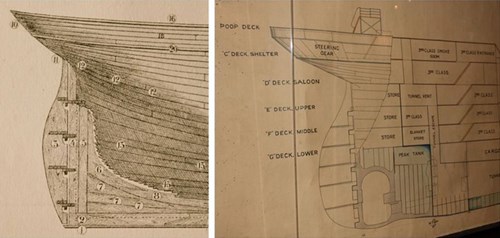
Above right, the stern and rudder arrangement of Titanic. The enlarged size of the blade, compared with a sailing vessel (above left), in order to compensate for the extra length.
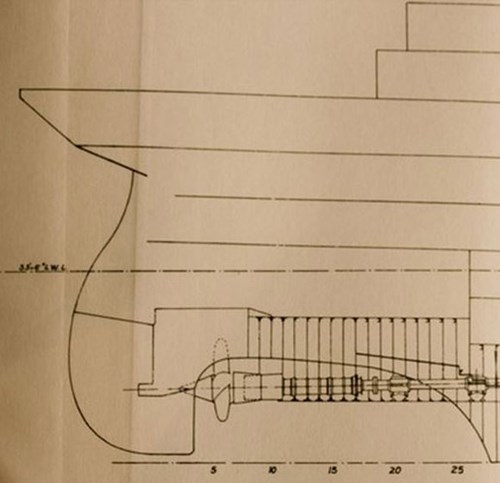
Compare Titanic's rudder design with Mauretania’s (above) and the differences are obvious. The Cunarder, with its balanced rudder, completely submerged and pivoted on the centre line, exerted the maximum turning effect - a basic feature of warship design. That was not the case with Titanic; why, after all, should a passenger vessel need to turn as quickly as a warship?
The answer lies with the service in which the two classes of vessel were intended to operate. Olympic and Titanic were designed solely for operation on the North Atlantic passenger service. The Cunarders were also designed for this service, but were duel purpose vessels - in time of war they would form part of Britain’s maritime reserve - serving as armed merchant cruisers or troop transports. Because of this the Admiralty stipulated a number of specifications for both vessels: high speed, manoeuvrability and above all, the ability to withstand torpedo attack. With their compartments sub-divided into smaller spaces any flooding would be restricted to a much smaller area. The Cunarders, unlike Olympic and Titanic, did not depend on cargo to off-set their enormous running costs.
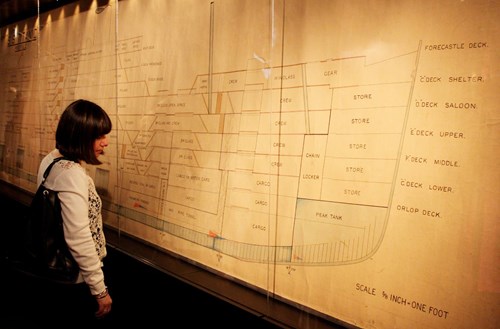
Above, the watertight subdivision as shown on Titanic’s longitudinal plan graphically illustrates the disaster which overtook her. The coloured chalk marks indicate the extent of underwater damage; six of her forward compartments were open to the sea. Pumps were able to keep the water down in the sixth compartment but the first five flooded out of control. This amount of damage had never been contemplated and, as the weight of water gradually pulled the bows lower, seawater eventually reached the top of the bulkheads flooding each compartment in turn. For the vessel to be truly watertight all the bulkheads would have to reach the weather deck (marked on the longitudinal plan ‘Shelter Deck’). The height of the bulkheads, above the waterline, was another compromise; raising their height further would require considerably more steel and extra watertight doors. Higher bulkheads would make operating the vessel far more difficult. The reduced and sub-divided spaces required for passengers and cargo would result in a substantial reduction in the earning potential of the vessel.
In the early 1900s the greatest danger to a passenger liner was from collision with another vessel specifically one striking the hull at right angles amidships and breaching a watertight bulkhead separating two of the vessels largest compartments. This ‘worst case scenario’ would result in the engine or boiler rooms flooding out of control, disabling the pumps and the vessel rapidly sinking. Titanic was designed and constructed to Harland & Wolff’s ‘special specifications’ to withstand this scenario. Many claims are made that Titanic was designed to remain afloat with three or even four of her forward compartments flooded but none of this is true. The only completely watertight compartment in the vessel was ‘A’. The so-called collision bulkhead, running from the tank top (the deck on which the engines and boilers are placed) to the weather deck (marked on the longitudinal plan ‘Shelter Deck’) was designed precisely for this scenario, to withstand a head-on collision. The bow and bulkhead behind would absorb the impact in a similar way in which a motorcar's crumple zone functions; the steel plating would concertina flat, the compartment behind flooding, but the rest of the vessel would remain watertight.
Like a world in miniature Titanic’s longitudinal plan contains a wealth of detail. Much of it to the casual observer is missed because the impression one gets is of the plan’s overwhelming size but a few minutes spent studying the layout of the 3rd Class passenger accommodation, for example, reveals another inbuilt problem; how do these passengers reach the Boat Deck in an emergency?
Titanic in many respects represents a confused picture. The 3rd Class were not treated badly, far from it, but they also did not have any of the ‘extras’ that other classes of passengers enjoyed. Yet, without this class of passenger and the enormous numbers wishing to cross the Atlantic, Titanic and her sisters would never have been constructed. It is also not true that White Star wanted to build larger liners than the competition. The reasons behind the design and construction of the ‘Olympic’ class are far more complex than pure competitive pressures. The United States Government planned to introduce new legislation requiring steamship companies to provide more space for 3rd Class (Steerage) passengers. This new legislation would restrict the number of emigrants a vessel could legally accommodate and thus considerably reduce income per voyage. The solution, in part, was to build larger vessels. Instead of maintaining a four ship service as before and the large numbers of crew required to operate them, the old service would be replaced with three giant steamers. More space for a larger number of passengers with only slightly increased crewing levels was a sound business model provided the 3rd Class traffic increased or at worse remained steady. Considerations about the amount of lifeboat accommodation and the abandonment of a vessel in an emergency were minor considerations - after all everyone believed Titanic was one enormous lifeboat. 15 April 1912 changed this complacent attitude regarding safety at sea forever.
During the British Inquiry it was stated it would take 3-4 minutes to reach the Boat Deck from the 3rd Class accommodation, but the test was made under very different circumstances to those prevailing on the night of 14-15 April. All the barriers between classes were removed allowing an unobstructed route directly to the boats for an individual who was familiar with the internal layout of the entire vessel. In reality the majority of 3rd Class, unlike their fellow passengers in 1st and 2nd Classes, had no idea how to reach the Boat Deck. In the confusion of abandonment and the mixed orders coming from the Bridge to keep the 3rd Class in their accommodation and to load them into boats from the lower deck ports, many were prevented from reaching the boats. There is also evidence to suggest officers and crew were concerned about the behaviour of passengers in an emergency. Attitudes towards foreigners, particularly those southern and eastern Europeans, suffered prejudice that they were likely to be ‘unstable’, ‘run a muck’ or not obey orders. Little or no consideration was given to their ability to speak or understand English and therefore it would hardly be surprising that any passenger might panic when faced with such an emergency.
What we learnt from the failure of Titanic’s design shaped the legislation concerning safety of life at sea and still influences the design and operation of large passenger vessels to this day. As an example of technology overstepping itself Titanic’s longitudinal plan is a monument to overarching confidence in outdated design; in the vessel’s creation one simple consideration was overlooked - the safety of passengers. Thankfully the reverse is true today.
Text and Images ©Paul Louden-Brown/White Star Line Archive
1. Cecil Arthur Allen lived with his wife and two young daughters a short distance away at 24 Marine Crescent, Waterloo overlooking the River Mersey. Two years later, in October 1914 Allen, aged just 47, was forced to resign through ill-health. The White Star Managers appreciated his long service with the Company and granted him a retiring allowance of £100 per year.
